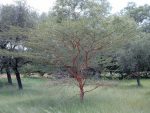 Also known as shittah tree, this evergreen tree is native to parts of northern Africa including Senegal, and Egypt where it grows in woodlands, wooded grassland, subtropical and tropical deserts, dry forest areas, lowlands, along watercourse, and near waterholes or seasonally flooded black cotton soils. It belongs to the legume family, Fabaceae, that also includes peanuts, sweet pea, and black locust. The tree grows up to 55′ tall although under 30′ in cultivation, and has a deep tap root, rust-colored powdery bark, and horizontal branches with large straight spines except on the tips where the spines are curved. The dark green, bipinnate leaves are 3-4″ long and have 10-12 pairs of leaflets about .5″ long. Rounded clusters of bright yellow flowers appear on 1″ long stems in the leaf axils during the dry season and give rise to light brown dry pods 4-6″ long containing several seeds. The tree is highly valued as an ornamental, and for fodder, wood and gum arabic, and has been used in folk medicine to treat a variety of ailments including dysentery, eye inflamation, rhinitis, bronchitis, arthritis, and hemorrhaging. The genus name, Vachell, honors George Harvey Vachell (1789-1839) chaplain to the British East India Company in Macoa, plant collector in China. The genus name, Acacia, is from the Greek word akis, meaning a point or a barb and refers to the thorns. The specific epithet, seyal, comes from an Arabic word for “torrent” used for the species in Egypt and refers to its association with water courses there.
Also known as shittah tree, this evergreen tree is native to parts of northern Africa including Senegal, and Egypt where it grows in woodlands, wooded grassland, subtropical and tropical deserts, dry forest areas, lowlands, along watercourse, and near waterholes or seasonally flooded black cotton soils. It belongs to the legume family, Fabaceae, that also includes peanuts, sweet pea, and black locust. The tree grows up to 55′ tall although under 30′ in cultivation, and has a deep tap root, rust-colored powdery bark, and horizontal branches with large straight spines except on the tips where the spines are curved. The dark green, bipinnate leaves are 3-4″ long and have 10-12 pairs of leaflets about .5″ long. Rounded clusters of bright yellow flowers appear on 1″ long stems in the leaf axils during the dry season and give rise to light brown dry pods 4-6″ long containing several seeds. The tree is highly valued as an ornamental, and for fodder, wood and gum arabic, and has been used in folk medicine to treat a variety of ailments including dysentery, eye inflamation, rhinitis, bronchitis, arthritis, and hemorrhaging. The genus name, Vachell, honors George Harvey Vachell (1789-1839) chaplain to the British East India Company in Macoa, plant collector in China. The genus name, Acacia, is from the Greek word akis, meaning a point or a barb and refers to the thorns. The specific epithet, seyal, comes from an Arabic word for “torrent” used for the species in Egypt and refers to its association with water courses there.
Type: Evergreen tree
Outstanding Feature: Gum arabic, wood for building, flowers
Form: Umbrella shaped crown
Growth Rate: Rapid
Bloom: Round clusters of bright yellow flowers during the dry season
Size: 20-55′ H
Light: Full sun (not shade tolerant)
Soil: Heavy clay-alluvium, medium moist to dry; drought tolerant
Hardiness: Zones 10-12
Care: Control insect pests
Pests and Diseases: Susceptible to damage by over 40 insects including wood borers; infection by Fomes rimosus, Ganoderma lucidum, Leveillula taurica, Ravenelia volkensii, Trametes meyenii, and Uromyces schweinfurthii.
Propagation: Seed, root suckering
Outstanding Selections: None
Photo Credit: Marco Schmidt Wikipedia